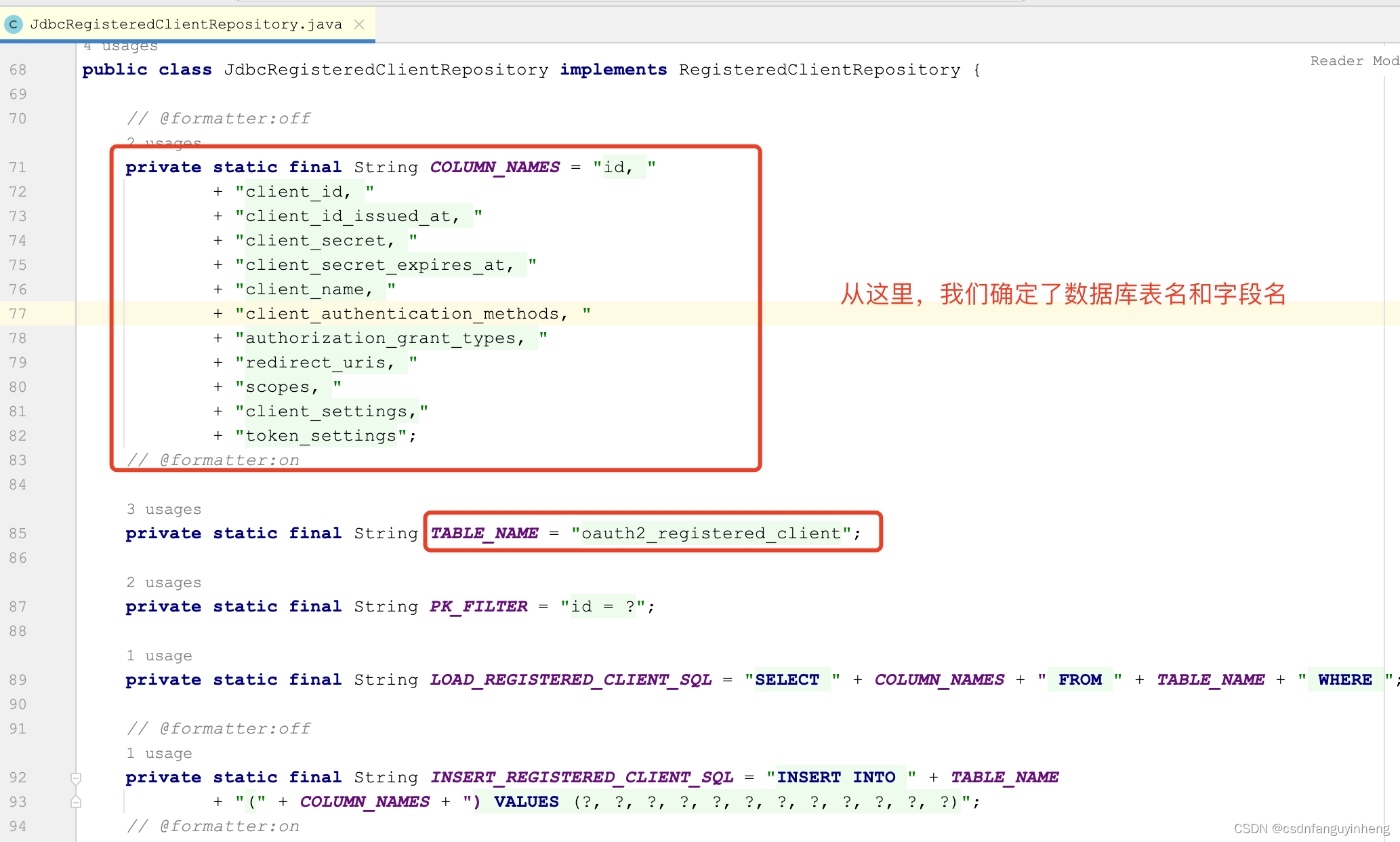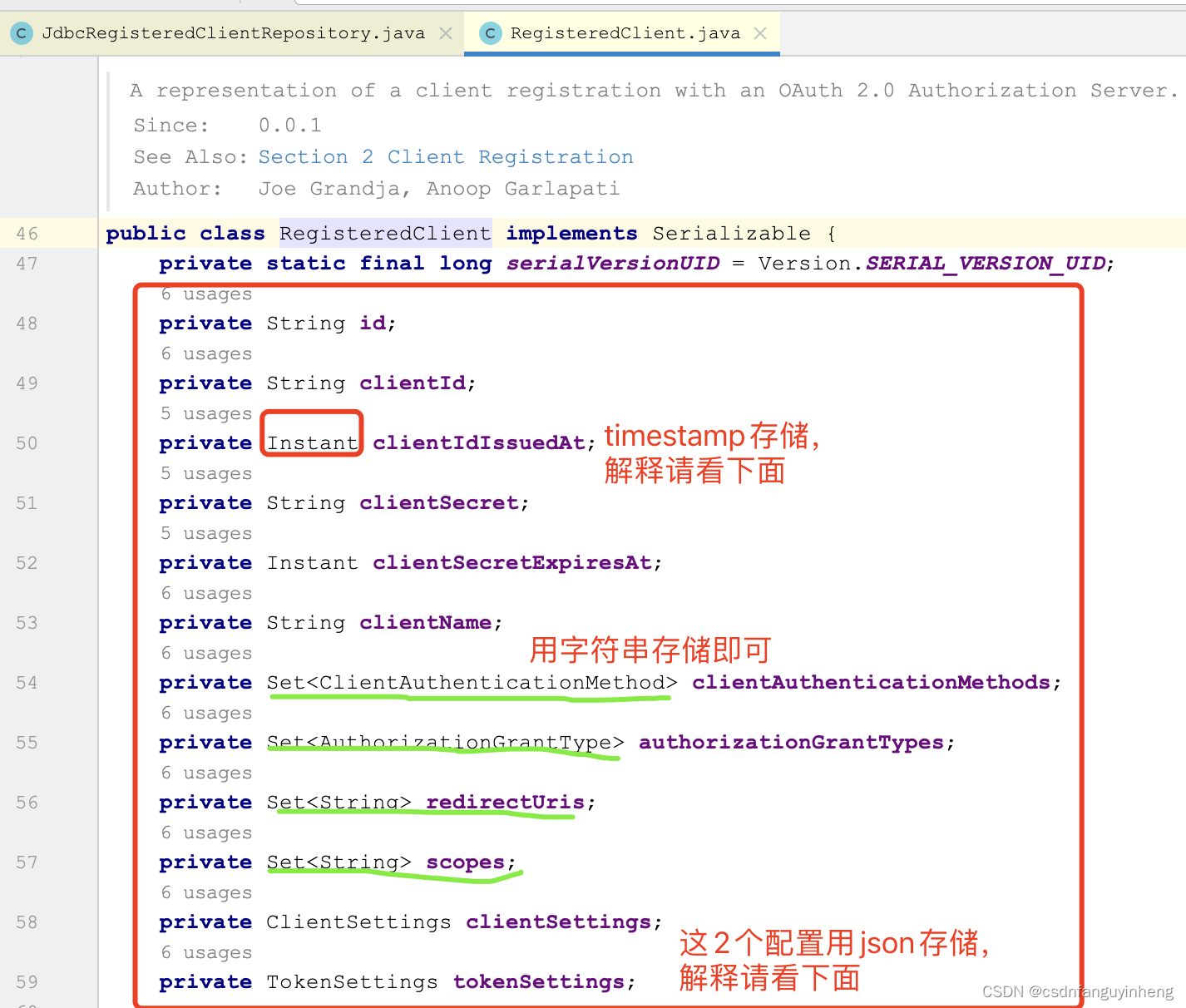篇二:springboot2.7 OAuth2 server使用jdbc存储RegisteredClient
2024-01-10 08:29:25
上一篇 <<springboot 2.7 oauth server配置源码走读一>>中简单描述了oauth2 server的配置,其中使用了内存保存 RegisteredClient,本篇改用mysql存储。
db存储需要创建表,表结构应该是什么样的呢,从spring给我们封装好的源码入手,
org.springframework.security.oauth2.server.authorization.client.JdbcRegisteredClientRepository类中:

那么字段类型呢?我们看org.springframework.security.oauth2.server.authorization.client.RegisteredClient类:

解释下为什么时间用timestamp存储以及Set数据模型用字符串存储:

解释下为什么ClientSettings和TokenSettings用json存储(当然varchar也行):就是一个map.


至此咱们确定了表结构,如下是一个示例:
CREATE TABLE `oauth2_registered_client` (
`id` varchar(36) COLLATE utf8mb4_general_ci NOT NULL,
`client_id` varchar(100) COLLATE utf8mb4_general_ci NOT NULL,
`client_id_issued_at` timestamp NOT NULL DEFAULT CURRENT_TIMESTAMP,
`client_secret` varchar(100) COLLATE utf8mb4_general_ci DEFAULT '',
`client_secret_expires_at` timestamp NULL DEFAULT NULL,
`client_name` varchar(50) COLLATE utf8mb4_general_ci NOT NULL,
`client_authentication_methods` varchar(100) COLLATE utf8mb4_general_ci NOT NULL,
`authorization_grant_types` varchar(100) COLLATE utf8mb4_general_ci NOT NULL,
`redirect_uris` varchar(100) COLLATE utf8mb4_general_ci DEFAULT '',
`scopes` varchar(200) COLLATE utf8mb4_general_ci NOT NULL,
`client_settings` json NOT NULL,
`token_settings` json NOT NULL,
PRIMARY KEY (`id`)
) ENGINE=InnoDB DEFAULT CHARSET=utf8mb4 COLLATE=utf8mb4_general_ci;
创建好表后,咱们处理代码:
1.在pom中引入依赖:
<dependency>
<groupId>org.springframework.boot</groupId>
<artifactId>spring-boot-starter-jdbc</artifactId>
</dependency>
<dependency>
<groupId>mysql</groupId>
<artifactId>mysql-connector-java</artifactId>
<version>8.0.26</version>
</dependency>
2.yaml/properties配置文件中添加数据库信息,示例如下:
spring:
datasource:
url: jdbc:mysql://localhost:3306/db?useUnicode=true&characterEncoding=utf-8&serverTimezone=Asia/Shanghai&useSSL=false
username: <username>
password: <password>
3.使用JdbcRegisteredClientRepository,它和InMemoryRegisteredClientRepository只能二选一,所以需要注释掉后者。在咱们自己的配置类OAuth2AuthorizeSecurityConfig中:
@Bean
public RegisteredClientRepository registeredClientRepository(JdbcTemplate jdbcTemplate) {
return new JdbcRegisteredClientRepository(jdbcTemplate);
}
4.初始化数据到db表中:写一个测试类方法插入数据:
package com.jel.tech.auth;
import org.junit.jupiter.api.Test;
import org.springframework.boot.test.context.SpringBootTest;
import org.springframework.security.oauth2.core.AuthorizationGrantType;
import org.springframework.security.oauth2.core.ClientAuthenticationMethod;
import org.springframework.security.oauth2.core.oidc.OidcScopes;
import org.springframework.security.oauth2.server.authorization.client.RegisteredClient;
import org.springframework.security.oauth2.server.authorization.client.RegisteredClientRepository;
import org.springframework.security.oauth2.server.authorization.config.ClientSettings;
import org.springframework.security.oauth2.server.authorization.config.TokenSettings;
import javax.annotation.Resource;
import java.time.Duration;
import java.util.UUID;
@SpringBootTest
class AuthApplicationTests {
@Resource
private RegisteredClientRepository registeredClientRepository;
@Test
void saveRegisteredClients() {
RegisteredClient loginClient = RegisteredClient.withId(UUID.randomUUID().toString())
.clientId("login-client")
.clientSecret("{noop}openid-connect")
.clientAuthenticationMethod(ClientAuthenticationMethod.CLIENT_SECRET_BASIC)
.authorizationGrantType(AuthorizationGrantType.AUTHORIZATION_CODE)
.authorizationGrantType(AuthorizationGrantType.REFRESH_TOKEN)
.redirectUri("http://127.0.0.1:8080/login/oauth2/code/login-client")
.redirectUri("http://127.0.0.1:8080/authorized")
.scope(OidcScopes.OPENID)
.scope(OidcScopes.PROFILE)
.clientSettings(ClientSettings.builder().requireAuthorizationConsent(true).build())
.build();
RegisteredClient registeredClient = RegisteredClient.withId(UUID.randomUUID().toString())
.clientId("messaging-client")
.clientSecret("{noop}secret")
.clientAuthenticationMethod(ClientAuthenticationMethod.CLIENT_SECRET_BASIC)
.authorizationGrantType(AuthorizationGrantType.CLIENT_CREDENTIALS)
.scope("message:read")
.scope("message:write")
// 指定token有效期:token:30分(默认5分钟),refresh_token:1天
.tokenSettings(TokenSettings.builder()
.accessTokenTimeToLive(Duration.ofMinutes(30))
.refreshTokenTimeToLive(Duration.ofDays(1))
.build())
.build();
// 注意:没有设置clientName,则会把id值作为clientName
registeredClientRepository.save(loginClient);
registeredClientRepository.save(registeredClient);
}
}
5.验证功能,在此我借花献佛,把官网提供的示例复制过来:
package com.jel.tech.auth;
import com.fasterxml.jackson.core.type.TypeReference;
import com.fasterxml.jackson.databind.ObjectMapper;
import org.junit.jupiter.api.Test;
import org.springframework.beans.factory.annotation.Autowired;
import org.springframework.boot.test.autoconfigure.web.servlet.AutoConfigureMockMvc;
import org.springframework.boot.test.context.SpringBootTest;
import org.springframework.http.HttpHeaders;
import org.springframework.mock.web.MockHttpServletRequest;
import org.springframework.test.context.ActiveProfiles;
import org.springframework.test.web.servlet.MockMvc;
import org.springframework.test.web.servlet.MvcResult;
import org.springframework.test.web.servlet.request.RequestPostProcessor;
import org.springframework.test.web.servlet.result.MockMvcResultHandlers;
import java.util.Map;
import static org.springframework.test.web.servlet.request.MockMvcRequestBuilders.post;
import static org.springframework.test.web.servlet.result.MockMvcResultMatchers.jsonPath;
import static org.springframework.test.web.servlet.result.MockMvcResultMatchers.status;
/**
* Integration tests for {@link AuthApplication}.
*
* @author Steve Riesenberg
*/
@SpringBootTest
@AutoConfigureMockMvc
@ActiveProfiles("test")
public class OAuth2AuthorizationServerApplicationITests {
private static final String CLIENT_ID = "messaging-client";
private static final String CLIENT_SECRET = "secret";
private final ObjectMapper objectMapper = new ObjectMapper();
@Autowired
private MockMvc mockMvc;
@Test
void performTokenRequestWhenValidClientCredentialsThenOk() throws Exception {
// @formatter:off
this.mockMvc.perform(post("/oauth2/token")
.param("grant_type", "client_credentials")
.param("scope", "message:read")
.with(basicAuth(CLIENT_ID, CLIENT_SECRET)))
.andExpect(status().isOk())
.andExpect(jsonPath("$.access_token").isString())
.andExpect(jsonPath("$.expires_in").isNumber())
.andExpect(jsonPath("$.scope").value("message:read"))
.andExpect(jsonPath("$.token_type").value("Bearer"));
// @formatter:on
}
@Test
void performTokenRequestWhenMissingScopeThenOk() throws Exception {
// @formatter:off
this.mockMvc.perform(post("/oauth2/token")
.param("grant_type", "client_credentials")
.with(basicAuth(CLIENT_ID, CLIENT_SECRET)))
.andExpect(status().isOk())
.andExpect(jsonPath("$.access_token").isString())
.andExpect(jsonPath("$.expires_in").isNumber())
.andExpect(jsonPath("$.scope").value("message:read message:write"))
.andExpect(jsonPath("$.token_type").value("Bearer"));
// @formatter:on
}
@Test
void performTokenRequestWhenInvalidClientCredentialsThenUnauthorized() throws Exception {
// @formatter:off
this.mockMvc.perform(post("/oauth2/token")
.param("grant_type", "client_credentials")
.param("scope", "message:read")
.with(basicAuth("bad", "password")))
.andExpect(status().isUnauthorized())
.andExpect(jsonPath("$.error").value("invalid_client"));
// @formatter:on
}
@Test
void performTokenRequestWhenMissingGrantTypeThenUnauthorized() throws Exception {
// @formatter:off
this.mockMvc.perform(post("/oauth2/token")
.with(basicAuth("bad", "password")))
.andExpect(status().isUnauthorized())
.andExpect(jsonPath("$.error").value("invalid_client"));
// @formatter:on
}
@Test
void performTokenRequestWhenGrantTypeNotRegisteredThenBadRequest() throws Exception {
// @formatter:off
this.mockMvc.perform(post("/oauth2/token")
.param("grant_type", "client_credentials")
.with(basicAuth("login-client", "openid-connect")))
.andExpect(status().isBadRequest())
.andExpect(jsonPath("$.error").value("unauthorized_client"));
// @formatter:on
}
@Test
void performIntrospectionRequestWhenValidTokenThenOk() throws Exception {
// @formatter:off
this.mockMvc.perform(post("/oauth2/introspect")
.param("token", getAccessToken())
.with(basicAuth(CLIENT_ID, CLIENT_SECRET)))
.andExpect(status().isOk())
.andExpect(jsonPath("$.active").value("true"))
.andExpect(jsonPath("$.aud[0]").value(CLIENT_ID))
.andExpect(jsonPath("$.client_id").value(CLIENT_ID))
.andExpect(jsonPath("$.exp").isNumber())
.andExpect(jsonPath("$.iat").isNumber())
.andExpect(jsonPath("$.iss").value("http://127.0.0.1:9000"))
.andExpect(jsonPath("$.nbf").isNumber())
.andExpect(jsonPath("$.scope").value("message:read"))
.andExpect(jsonPath("$.sub").value(CLIENT_ID))
.andExpect(jsonPath("$.token_type").value("Bearer"))
.andDo(MockMvcResultHandlers.print())
;
// @formatter:on
}
@Test
void performIntrospectionRequestWhenInvalidCredentialsThenUnauthorized() throws Exception {
// @formatter:off
this.mockMvc.perform(post("/oauth2/introspect")
.param("token", getAccessToken())
.with(basicAuth("bad", "password")))
.andExpect(status().isUnauthorized())
.andExpect(jsonPath("$.error").value("invalid_client"));
// @formatter:on
}
private String getAccessToken() throws Exception {
// @formatter:off
MvcResult mvcResult = this.mockMvc.perform(post("/oauth2/token")
.param("grant_type", "client_credentials")
.param("scope", "message:read")
.with(basicAuth(CLIENT_ID, CLIENT_SECRET)))
.andExpect(status().isOk())
.andExpect(jsonPath("$.access_token").exists())
.andReturn();
// @formatter:on
String tokenResponseJson = mvcResult.getResponse().getContentAsString();
Map<String, Object> tokenResponse = this.objectMapper.readValue(tokenResponseJson, new TypeReference<Map<String, Object>>() {
});
String access_token = tokenResponse.get("access_token").toString();
System.out.println(access_token);
return access_token;
}
private static BasicAuthenticationRequestPostProcessor basicAuth(String username, String password) {
return new BasicAuthenticationRequestPostProcessor(username, password);
}
private static final class BasicAuthenticationRequestPostProcessor implements RequestPostProcessor {
private final String username;
private final String password;
private BasicAuthenticationRequestPostProcessor(String username, String password) {
this.username = username;
this.password = password;
}
@Override
public MockHttpServletRequest postProcessRequest(MockHttpServletRequest request) {
HttpHeaders headers = new HttpHeaders();
headers.setBasicAuth(this.username, this.password);
request.addHeader("Authorization", headers.getFirst("Authorization"));
return request;
}
}
}
文章来源:https://blog.csdn.net/csdnfanguyinheng/article/details/135394002
本文来自互联网用户投稿,该文观点仅代表作者本人,不代表本站立场。本站仅提供信息存储空间服务,不拥有所有权,不承担相关法律责任。 如若内容造成侵权/违法违规/事实不符,请联系我的编程经验分享网邮箱:veading@qq.com进行投诉反馈,一经查实,立即删除!
本文来自互联网用户投稿,该文观点仅代表作者本人,不代表本站立场。本站仅提供信息存储空间服务,不拥有所有权,不承担相关法律责任。 如若内容造成侵权/违法违规/事实不符,请联系我的编程经验分享网邮箱:veading@qq.com进行投诉反馈,一经查实,立即删除!